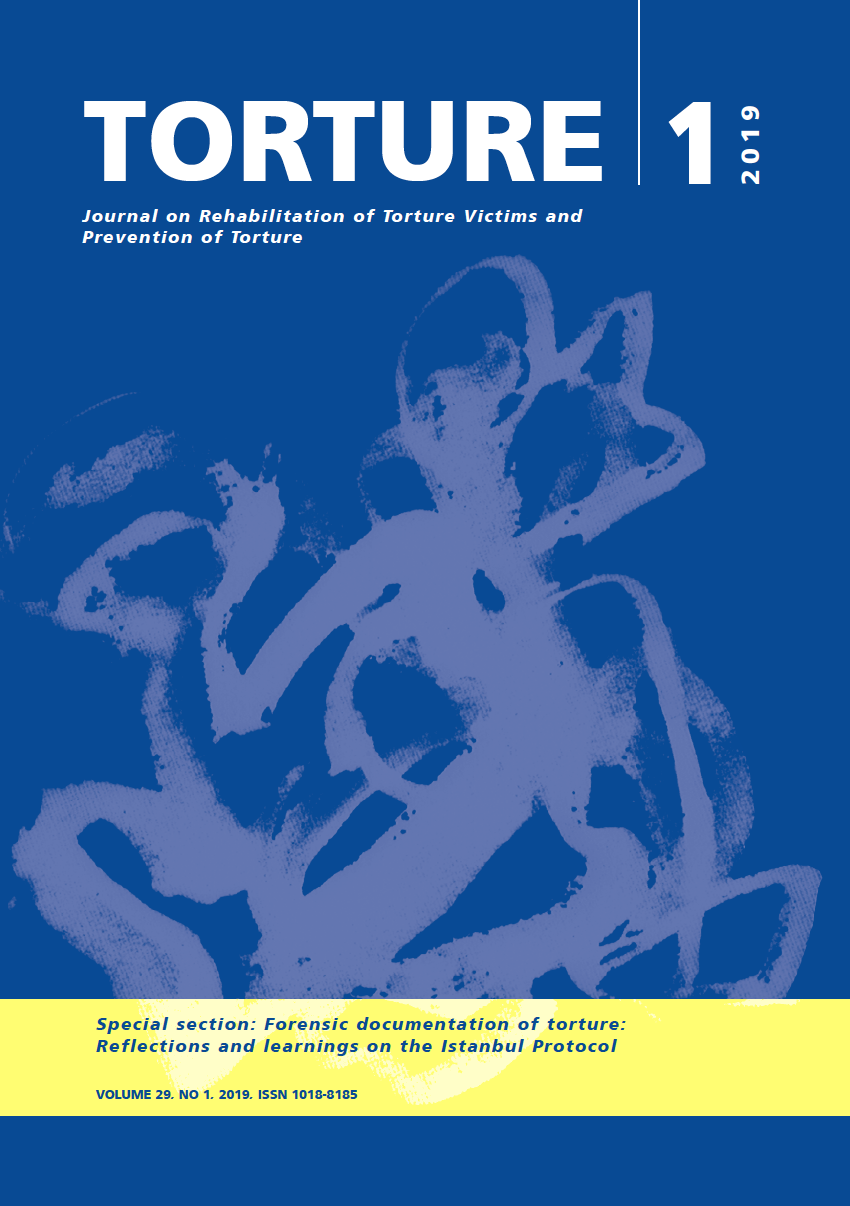The Istanbul Protocol: A global stakeholder survey on past experiences, current practices and additional norm setting
DOI:
https://doi.org/10.7146/torture.v29i1.111428Keywords:
Istanbul Protocol, forensic documentation, torture, stakeholder surveyAbstract
Introduction: The Istanbul Protocol (IP) principles and guidelines have served as international norms for the effective investigation and documentation of torture and ill-treatment since 1999. Given the widespread use of the IP and recent calls to update or enhance its norms, we conducted a large-scale study among stakeholders to understand current practices as well as opinions on additional IP norm setting. Methods: Between February 20, 2017 and April 7, 2017, we conducted an online survey of IP users using a combination of criterion and chain sampling. The survey instrument included the following domains of inquiry: 1) respondent characteristics (demographics, anti-torture work, country conditions, and IP training); 2) IP use, importance and practices, and; 3) opinions on additional IP norm setting. Results: The survey was distributed to 177 individuals and 250 organizational representatives with response rates of 78% and 47% respectively. The respondents came from a variety of clinical, legal, academic, and advocacy disciplines from around the world. The respondents indicated that they use the IP for a wide range of anti-torture activities: investigation and documentation, advocacy, training and capacity building, policy reform, prevention, and treatment and rehabilitation of torture survivors. The vast majority (94% of individual respondents and 84% of organizations) reported that the IP is important to their anti-torture work. A majority of individual (60%) and organizational (59%) respondents reported that updating or adding clarifications to the IP would help to address the challenges they face and provided specific suggestions. However, 41% of individuals and 21% of organizational respondents also reported concerns that additional IP norm setting could have negative consequences. Discussion: The IP provides critical guidance for a wide range of torture prevention, accountability, and redress activities and can be enhanced through the development of additional updates and clarifications to respond to the current needs of torture survivors and stakeholders.
References
Forensic Proof, Medical Records Key in Halting Torture, Special Rapporteur Tells Third Committee as Human Rights
Debate Begins. (2014, October 21). Retrieved from https://www.un.org/press/en/2014/gashc4107.doc.htm
Furtmayr, H., & Frewer, A. (2010). Documentation of torture and the Istanbul Protocol: applied medical ethics. Medicine, Health Care and Philosophy, 3(13), 279–286. https://doi.org/10.1007/s11019-010-9248-1
Haagensen, J. O. (2007). The role of the Istanbul-Protocol in the uphill battle for torture survivors being granted asylum in Europe and ensuring the perpetrators pay. Torture Journal, 17(3), 236–239.
Iacopino, V. (2017). The Istanbul Protocol: development, practical applications and future directions. In J. Payne-James, J. Beynon, R. Byard, & V. Duarte (Eds.), Monitoring Detention, Custody, Torture and Ill Treatment: A Practical Approach to Prevention and Documentation. CRC Press.
Kalt, A., Hossain, M., Kiss, L., & Zimmerman, C. (2013). Asylum Seekers, Violence and Health: A Systematic Review of Research in High-Income Host Countries. American Journal of Public Health, 103(3), e30–e42. https://doi.org/10.2105/AJPH.2012.301136
Kelly, T. (2016). A Comparative Study of the Use of the Istanbul Protocol among Civil Society Organizations in Low-income Countries. Torture, 26(3), 60–73.
Ludwig Boltzmann Institute of Human Rights. (2016, October 12). More than 200 experts discussed how to improve torture investigation and documentation in Bishkek, Kyrgyzstan. Ludwig Boltzmann Institute of Human Rights. Retrieved from http://bim.lbg.ac.at/en/story/news/more-200-experts-discussed-how-improve-torture-investigation-and-documentation-bishkek-kyrgyzstan
Masmas, T. N., Møller, E., Buhmannr, C., Bunch, V., Jensen, J. H., Hansen, T. N., … Ekstrøm, M. (2008). Asylum seekers in Denmark--a study of health status and grade of traumatization of newly arrived asylum seekers. Torture Journal, 18(2), 77–86.
Moreno, A., & Iacopino, V. (2008). Forensic investigations of torture and ill-treatment in Mexico. A follow-up study after the implementation of the Istanbul Protocol. Journal of Legal Medicine (TF), 29(4), 443–478. https://doi.org/10.1080/01947640802494820
Otter, J. J. den, Smit, Y., Cruz, L. B. dela, Özkalipci, Ö., & Oral, R. (2013). Documentation of torture and cruel, inhuman or degrading treatment of children: A review of existing guidelines and tools. Forensic Science International, 1–3(224), 27–32. https://doi.org/10.1016/j.forsciint.2012.11.003
Park, R., & Oomen, J. (2010). Context, evidence and attitude: the case for photography in medical examinations of asylum seekers in the Netherlands. Social Science & Medicine (1982), 71(2), 228–235. https://doi.org/10.1016/j.socscimed.2010.01.049
Perera, C., & Verghese, A. (2011). Implementation of Istanbul Protocol for effective documentation of torture – review of Sri Lankan perspectives. Journal of Forensic and Legal Medicine, 18(1), 1–5. https://doi.org/10.1016/j.jflm.2010.09.010
Piwowarczyk, L., Moreno, A., & Grodin, M. (2000). Health Care of Torture Survivors. JAMA, 284(5), 539–541. https://doi.org/10.1001/jama.284.5.539
Ucpinar, H., & Baykal, T. (2006). An important step for prevention of torture. The Istanbul protocol and challenges. Torture Journal, 16(3), 252–267.
UN Press Release. “Forensic Proof, Medical Records Key in Halting Torture, Special Rapporteur Tells Third Committee as Human Rights Debate Begins.” October 21, 2014. https://www.un.org/press/en/2014/gashc4107.doc.htm.
UNHCHR. (1999). Istanbul Protocol. Manual on the Effective Investigation and Documentation of Torture and Other Cruel, Inhuman or Degrading Treatment or Punishment (2nd ed.). Retrieved from http://www.ohchr.org/Documents/Publications/training8Rev1en.pdf
United Nations Office of the High Commissioner for Human Rights. (2018). The Minnesota Protocol on the Investigation of Potentially Unlawful Death 2016: The Revised United Nations Manual on the Effective Prevention and Investigation of Extra-Legal, Arbitrary and Summary Executions. https://doi.org/10.18356/0389ae17-en
Visentin, S., Pelletti, G., Bajanowski, T., & Ferrara, S. D. (2017). Methodology for the identification of vulnerable asylum seekers. International Journal of Legal Medicine, 131(6), 1719–1730. https://doi.org/10.1007/s00414-017-1645-z
Downloads
Additional Files
Published
How to Cite
Issue
Section
License
We accept that some authors (e.g. government employees in some countries) are unable to transfer copyright. The Creative Commons Licence Attribution-NonCommercial-NoDerivatives 4.0 International (CC BY-NC-ND 4.0) covers both the Torture Journal and the IRCT web site. The publisher will not put any limitation on the personal freedom of the author to use material contained in the paper in other works which may be published, provided that acknowledgement is made to the original place of publication.


